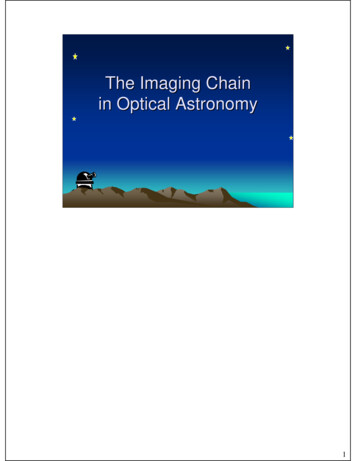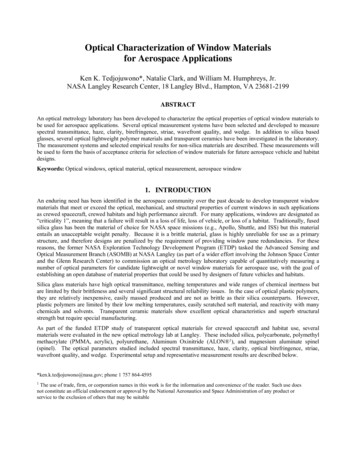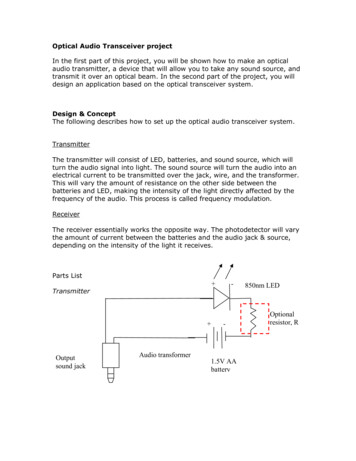
Transcription
The Imaging Chainin Optical Astronomy1
Review and Overview“Imaging Chain” includes these elements:1.2.3.4.5.6.7.8.energy sourceobjectcollectordetector (or sensor)processordisplayanalysisstorage (if any)2
Optical Imaging Chain1: source5: processing2: object3: collector4: sensor6: display7: analysis3
Source and/or Object In astronomy, the source of energy (1) and theobject (2) are almost always one and the same! i.e., The object emits the light– Examples: Galaxies Stars– Exceptions: Planets and the moon Dust and gas that reflects or absorbs starlight4
Optical Imaging Chain inAstronomy until 1980 or so5: processing1: source2: object6: display7: analysis3: collector4: sensor8: storage(stack of glass)5
Optical Imaging Chain in ModernAstronomy (post-1980)5: processing1: source2: object6: display7: analysis3: collector4: sensor8: storage6
Transition (“Catch-up”) Phase:Digitize Plates6: display7: analysis Scanner8: storage7
Optical Imaging Chain in RadioAstronomy1,23,4radio wavesreceiver wherewaves are collectedwavesconverted intoelectro signals5computerreceived as signal6,78
Specific Requirements forAstronomical Imaging Systems Requirements always conflict– Always want more than you can have must “trade off” desirable attributes Deciding the relative merits is a difficult task “general-purpose” instruments (cameras) may not besufficient Want simultaneously to have:– excellent angular resolution AND wide field of view– high sensitivity AND wide dynamic range Dynamic range is the ability to image “bright” and “faint”sources– broad wavelength coverage AND ability to measurenarrow spectral lines9
Angular Resolutionvs. Field of View Angular Resolution: ability to distinguish sourcesthat are separated by small angles– Limited by: Optical Diffraction Sensor Resolution Field of View: angular size of the image field– Limited by: Optics Sensor Size (area)10
Sensitivity vs. Dynamic Range Sensitivity– ability to measure faint brightness Dynamic Range– ability to image “bright” and “faint” sources in samesystem11
Wavelength Coveragevs. Spectral Resolution Wavelength Coverage– Ability to image over a wide range of wavelengths– Limited by: Spectral Transmission of Optics (Glass cuts off UV, far IR) Spectral Resolution– Ability to detect and measure narrow spectral lines– Limited by: “Spectrometer” Resolution (number of lines in diffractiongrating)12
Optical Collector (Link #3)13
Optical Collection (Link #3):Refracting Telescopes Lenses collect light BIG disadvantages– Chromatic Aberrations (due to dispersion of glass)– Lenses are HEAVY and supported only on periphery Limits the Lens Diameter Largest is 40" at Yerkes Observatory, le3.jpg14
Optical Collection (Link #3):Reflecting Telescopes Mirrors collect light Chromatic Aberrations eliminated Fabrication techniques continue to improve Mirrors may be supported from behind Mirrors may be made much larger thanrefractive lenses15
Optical Reflecting Telescopes Concaveparabolic primarymirror to collectlight from source– modern mirrorsfor largetelescopes arethin, lightweight &deformable, tooptimize imagequality3.5 meterWIYNtelescopemirror, KittPeak, Arizona16
Thin and Light (Weight) Mirrors Light weight Easier to point– “light-duty” mechanical systems cheaper Thin Glass Less “Thermal Mass”– Reaches Equilibrium (“cools down” to ambienttemperature) quicker17
Hale 200" TelescopePalomar Mountain, CAhttp://www.cmog.org/page.cfm?page mar/overview.html18
200" mirror (5 meters)for Hale Telescope Monolithic Mirror (single piece)Several feet thick10 months to cool7.5 years to grindMirror weighs 20 tonsTelescope weighs 400 tons“Equatorial” Mount– follows sky with one motion19
Keck telescopes, Mauna Kea, HIhttp://www2.keck.hawaii.edu/geninfo/about.html20
400" mirror (10 meters)for Keck Telescope 36 segments 3" thick Each segment weighs 400 kg (880 pounds)– Total weight of mirror is 14,400 kg ( 15 tons) Telescope weighs 270 tons “Alt-azimuth” mount (left-right, up-downmotion)– follows sky with two motions rotation21
Basic Designs of OpticalReflecting Telescopes1. Prime focus: light focused by primary mirror alone2. Newtonian: use flat, diagonal secondary mirror todeflect light out side of tube3. Cassegrain: use convex secondary mirror to reflectlight back through hole in primary4. Nasmyth (or Coudé) focus (coudé French for“bend” or “elbow”): uses a tertiary mirror to redirectlight to external instruments (e.g., a spectrograph)22
Prime FocusSensorfMirror diameter must be large to ensure thatobstruction is not significant23
Newtonian ReflectorSensor24
Cassegrain TelescopeSensorSecondaryConvex Mirror25
Feature of CassegrainTelescope Long Focal Length inShort TubefLocation ofEquivalent Thin Lens26
Coudé or Nasmyth TelescopeSensor27
Optical Reflecting TelescopesSchematicof 10-meterKecktelescope(segmentedmirror)28
Large Optical TelescopesTelescopes with largest diameters(in use or under construction:– 10-meter Keck (Mauna Kea,Hawaii)– 8-meter Subaru (Mauna Kea)– 8-meter Gemini (twin telescopes:Mauna Kea & Cerro Pachon,Chile)– 6.5-meter Mt. Hopkins (Arizona)– 5-meter Mt. Palomar (California)– 4-meter NOAO (Kitt Peak, AZ &Cerro Tololo, Chile)Kecktelescopemirror(noteperson)Summit of Mauna Kea, with Maui in s.html29
Why Build Large Telescopes?1. Larger Aperture Gathers MORE Light– Light-Gathering Power Area– Area of Circular Aperture πD2 / 4 D2 D diameter of primary collecting element2. Larger aperture better angularresolution– recall that: θ λD30
Why Build Small Telescopes?1. Smaller aperture collects less light less chance of saturation(“overexposure”) on bright sources2. Smaller aperture larger field of view(generally)–Determined by “F ratio” or “F#”F# fDf focal length of collecting elementD diameter of aperture31
F Ratio: F# F# describes the ability of the optic to“deflect” or “focus” light– Smaller F# optic “deflects” light more thansystem with larger F#Small F#Large F#32
F# of Large Telescopes Hale 200" on Palomar: f/3.3– focal length of primary mirror is:3.3 200" 660" 55' 16.8 m– Dome must be large enough to enclose Keck 10-m on Mauna Kea: f/1.75– focal length of primary mirror is:1.75 10m 17.5 m 58 m33
F Ratio: F# Two reflecting telescopes with different F#and same detector have different “Fields ofView”:large θSmall F#small θLarge F#34
Sensors (Link #4)35
Astronomical CamerasUsually Include:1. Spectral Filters––most experiments require specific wavelengthrange(s)broad-band or narrow-band2. “Reimaging” Optics–enlarge or reduce image formed by primarycollecting element3. Light-Sensitive Detector: Sensor36
Astronomical Sensors Most common detectors:– Human Eye– Photographic Emulsion film plates– Electronic Sensors CCDs37
Angular Resolution Fundamental Limit due to Diffraction in“Optical Collector” (Link #3) θ λD But Also Limited by Resolution of Sensor!38
Charge-Coupled Devices (CCDs) Standard light detection medium for BOTH professional andamateur astronomical imaging systems– Significant decrease in price numerous advantages over film:– high quantum efficiency (QE) meaning most of the photons incident on CCD are “counted”– linear response measured signal is proportional to number of photons collected– fast processing turnaround (CCD readout speeds 1 sec) NO development of emulsion!– regular grid of sensor elements (pixels) as opposed to random distribution of AgX grains– image delivered in computer-ready form39
Sensor Resolution Obvious for Electronic Sensors (e.g.,CCDs) Elements have finite size Light is summed over areaof sensor element (“integrated”) Light from two stars that falls onsame element is added together stars cannot be distinguishedin image! x40
Same Effect in PhotographicEmulsions More difficult to quantify Light-sensitive “grains” of silverhalide in the emulsion Placed “randomly” in emulsion “Random” sizes “large” grains are more sensitive (respond to few photons) “small” grains produce betterresolution41
Photographic techniques:silver halide Film– Emulsion on “flexible” substrate– Still used by amateurs using sensitive film B&W and color Special treatment to increase sensitivity Photographic Plates– Emulsion on glass plates– Most common detector from earliest developmentof AgX techniques until CCDs in late 70’s42
Eye as Astronomical Detector Eye includes its own lens– focuses light on retina ( “sensor”) When used with a telescope, must add yetanother lens– redirect rays from primary optic– make them parallel (“collimated”) rays appear to come from “infinity” (infinite distanceaway)– reimaging is performed by “eyepiece”43
Eye with TelescopeWithout EyepieceWith EyepieceLight entering eyeis “collimated”44
Eye as Astronomical Detector Point sources (stars) appear brighter to eye throughtelescope Factor isD2P2– D is telescope diameter– P is diameter of eye pupil– Magnification should make light fill the eye pupil (“exit pupil”) Extended sources (for example, nebulae) do notappear brighter through a telescope– Gain in light gathering power exactly compensated by imagemagnification, spreads light out over larger angle.45
Atmospheric Effects on Image Large role in ground-based optical astronomy– scintillation modifies source angular size twinkling of stars “smearing” of point sources– extinction reduces light intensity atmosphere scatters a small amount of light, especially atshort (bluer) wavelengths water vapor blocks specific wavelengths, especially nearIR– scattered light produces interfering “background” astronomical images are never limited to light fromsource alone; always include “source” “backgroundsky” “light pollution” worsens sky background46
Scattering “Wavelength Dependent”– Depends on color of light– Long wavelengths are scattered “less”47
Scattering by Molecules"Rayleigh Scattering" 1λ4 Molecules are SMALL “Blue” light is scattered MUCH more thanred light– Reason for BOTH blue sky (blue light scattered from sun in alldirections) red sunset (blue light is scattered out of the sun’sdirect rays)48
Scattering by Dust"Mie Scattering" 1λ Dust particles are MUCH larger thanmolecules– e.g., from volcanos, dust storms Blue light is scattered by dust “somewhatmore” than red light49
Link #5: Image Processing50
Link #5: Image Processing Formerly: performed in darkroom– e.g., David Malin’s “Unsharp Masking” Subtract a blurred copy from a “sharp” positive (or, add a blurred negative to a “sharp” positive) Now performed in computers, e.g.,– contrast enhancement– “sharpening”– “normalization” (background division)– 51
Image Processing Once collected, images must be corrected for:– Atmosphere (to extent possible) e.g., sequence of images obtained at a variety of telescopeelevations usually can be corrected for atmosphericextinction– CCD defects and artifacts dark current– CCD pixel reports a signal even when not exposed to light bad pixels– some pixels will be dead, hot, or even “flickering” variations in pixel-to-pixel sensitivity– every pixel has its own QE– can be characterized by “flat field”52
Links #6 and #7Image Display and Analysis53
Image Display and Analysis This step often is where astronomy really begins. Type and extent of display and analysis depends onpurpose of imaging experiment Common examples:– evaluating whether an object has been detected or not– determining total CCD signal (counts) for an object, such asa star– determining relative intensities of an object from images attwo different wavelengths– determining relative sizes of an extended object from imagesat two different wavelengths54
Link #8: Storage55
Storage Glass plates– Lots of climate-controlled storage space– expensive– available to one user at a time– now being “digitized” (scanned), as in thearchive you use with DS9 Digital Images– Lots of disk space– cheaper all the time– available to many users56
computer received as signal 3,4 5 6,7. 9 Specific Requirements for Astronomical Imaging Systems . "Reimaging" Optics - enlarge or reduce image formed by primary collecting element 3. Light-Sensitive Detector: Sensor. 37 Astronomical Sensors Most common detectors: - Human Eye











